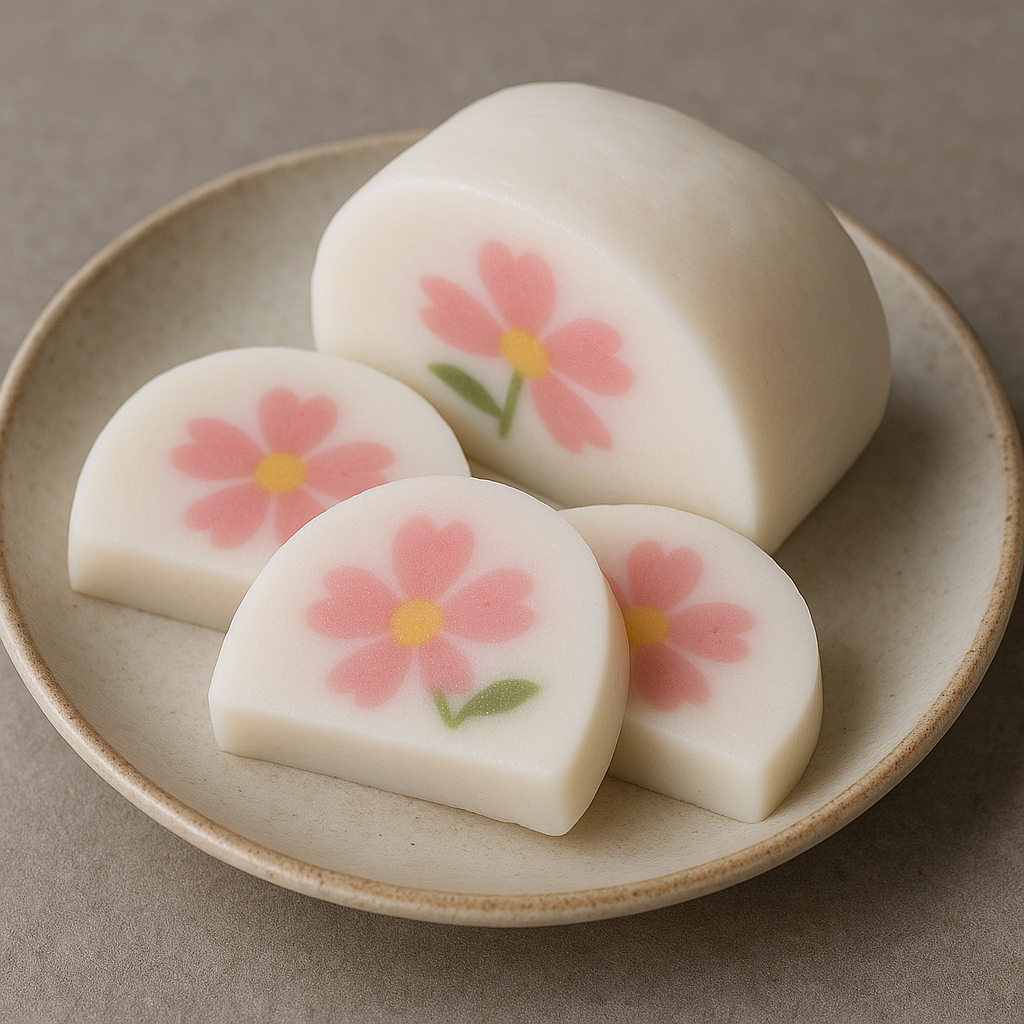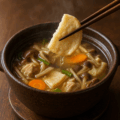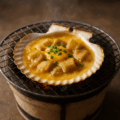べこもちの特徴
端午の節句のハレ菓子、いまは日常のおやつにも
べこもちは、端午の節句に食されてきた行事菓子で、現在はおやつとしても親しまれています。主な伝承地域は下北地方です。
原型は「くじらもち」―北前船で伝来
うるち米粉ともち米粉に水と砂糖を加えて蒸す「くじらもち」が原型とされ、江戸期に北前船を介して伝わったと考えられています。
進化する色柄と呼び名
1960年代ごろ大間町を中心に花模様入りが発展し、美しい色彩と柄の「べこもち」に。近年はSNS発の普及も進み、「デコもち」といった現代的アレンジも生まれています。
食べ方
生地を色分けして組み、かまぼこ状にまとめて蒸す「金太郎飴」式。食べるときはスライスして再度蒸すのが一般的で、焼いても美味です。
べこもち(レシピ/30人分)
材料
- もち米粉 … 750g
- うるち米粉 … 750g
- 砂糖 … 500g
- 塩 … 大さじ1/2
- 熱湯 … 1.5カップ
- ぬるま湯 … 1〜1.5カップ
- 着色用 … 茶(インスタントコーヒー等)適宜
作り方(要約)
- 粉類(もち米粉・うるち米粉・砂糖・塩)を合わせ、熱湯を回しかけて全体をしめらせる。
- ぬるま湯を少しずつ加えて耳たぶ程度にこねる。生地の一部を着色して玉状に分ける。
- 白生地で色玉を包んで小判状に整え、段に重ねて中央を押さえ、模様の核をつくる。
- 残りの白生地でも同様に成形し、切り込みを入れて口をすぼめ、模様を際立たせる。
- 土台となる白生地を板状にし、模様パーツを並べてサンドし、かまぼこ形に整える。
- 棒状にのばし、1cm幅に切る。蒸し器で10〜15分蒸す。
- 出来たてはそのまま、冷めたら再蒸し・焼き・電子レンジ温めでもOK。冷凍保存も可。
食習の時季としつらえ
月遅れの端午(6月5日)には笹で包んだべこもちを神棚に供え、のちに子どもへ振る舞う習わしがあります。
English Version
Features of Beko-mochi
A Festive Sweet for Boys’ Day—Now an Everyday Treat
Beko-mochi is a confection traditionally eaten for the Boys’ Festival (Tango no Sekku), and today it’s also enjoyed as a casual snack. The main area of transmission is the Shimokita region of Aomori.
Origin in “Kujira-mochi” — Brought by the Kitamae-bune Trade
Its prototype is said to be kujira-mochi, made by steaming a mixture of non-glutinous rice flour and glutinous rice flour with water and sugar, believed to have arrived during the Edo period via the Kitamae-bune coastal trade routes.
Evolving Colors, Patterns, and Names
Around the 1960s, especially in Ōma Town, floral motifs developed, giving rise to today’s beautifully colored and patterned “beko-mochi.” In recent years, social media has helped spread modern variations such as “deco-mochi.”
How to Enjoy
The dough is divided by color, assembled, and shaped into a loaf (like a “Kintarō candy” cross-section). To serve, slice and steam again briefly; pan-toasting is delicious as well.
Beko-mochi (Recipe / for 30 servings)
Ingredients
- Glutinous rice flour (mochiko) … 750 g
- Non-glutinous rice flour (jōshinko) … 750 g
- Sugar … 500 g
- Salt … 1/2 tbsp
- Boiling water … 1.5 cups
- Lukewarm water … 1–1.5 cups
- Coloring … brown (e.g., instant coffee), as needed
Method (Summary)
- Combine dry ingredients (both rice flours, sugar, salt). Sprinkle with boiling water to moisten evenly.
- Add lukewarm water little by little and knead until earlobe-soft. Tint part of the dough and divide into small balls.
- Wrap colored balls with white dough, shape into ovals, stack in layers, and press the centers to form the core of the pattern.
- Form additional ovals similarly; make shallow cuts and pinch to accentuate the motif.
- Roll out a base sheet of white dough, arrange the motif pieces, sandwich with another sheet, and shape into a kamaboko-like loaf.
- Roll into a log, slice into 1-cm pieces, and steam 10–15 minutes.
- Serve warm as is; when cooled, re-steam, pan-toast, or microwave to reheat. Suitable for freezing.
(Source: Summary of the recipe steps from MAFF’s “Our Regional Cuisines.”)
Season & Customs
For the month-late Boys’ Festival (June 5), it is customary to wrap beko-mochi in bamboo leaves, offer them at the household shrine, and later share them with children.



何でも質問してください!